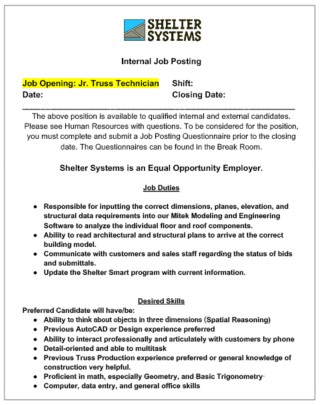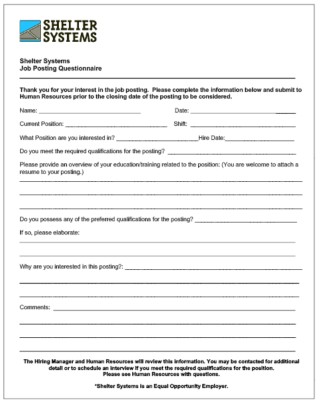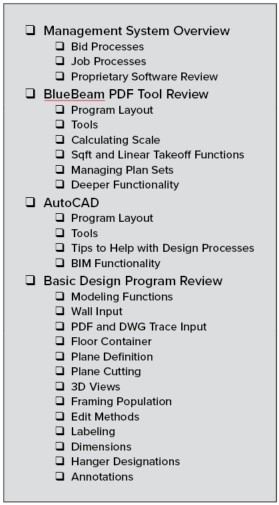Building a Great Team
Finding Design Talent for Your Team is a Process
By Tony Acampa
When I can share space with fellow design managers, either at an OQM or BCMC, the question I get asked the most is, “What does your hiring and training process look like for your design team?”
 Now, I do not have all the answers, and neither do I claim that our process at Shelter Systems is the only way or the right way, but we have been successful with what we are doing. So, I’d like to take the opportunity to share my insights into our hiring and training processes and identify what I’ve learned during my journey.
Now, I do not have all the answers, and neither do I claim that our process at Shelter Systems is the only way or the right way, but we have been successful with what we are doing. So, I’d like to take the opportunity to share my insights into our hiring and training processes and identify what I’ve learned during my journey.
When it comes to hiring, first, you must understand that you already have a pool of talented and exceptional people available to you: your existing employees. I’m not alone when I say our greatest success stories come from providing career path opportunities for our existing team throughout all levels of our organization. What does that look like? Is it as simple as posting a job opening for a designer in the break room? Is it setting up first- and second-round interviews and providing personality and aptitude assessments for each potential hire? Then pick the best one?
The truth is, it can be that easy! But first, we need to take a step back. It is important to evaluate your current design department team, paying attention to the mix of your team and their personalities, strengths, and weaknesses. Do they love what they do? How do they handle adversity? Which ones are teachers? Understanding these personnel attributes are vital when you are ready to expand your team.

Fig. 1
The key to a new designer’s success is the culture of your current design team. I encourage you to begin your hiring process there. When you can trust your team to surround a new hire with acceptance, knowledge, and support, it ensures that the new employee feels welcome and informed and has the necessary assistance to integrate smoothly into the team and their role.
When Shelter Systems begins the hiring process for a junior truss technician, we look internally first. The job is posted (see Fig. 1) at key locations in the breakroom so that it is visible to everyone. Interested candidates must fill out and turn in a job posting questionnaire (see Fig. 2). After the closing date, the first round of interviews is scheduled with the potential candidates. These questions asked are geared towards and hyper-focused on the candidates’ skills and experience. In addition, the candidates are given the TATO I: SBCA’s Technical Assessment Test Online. What I value the most in the test result is the 3D visual skills or spatial reasoning portion. This determines who makes it to the next round. If I have a candidate who excels in spatial reasoning (the ability to understand how objects move or appear and relate to one another in a three-dimensional world), they have the potential to be a great truss technician.

Fig. 2
Our second round of interviews is more tailored towards the candidate’s personality attributes. As mentioned earlier, culture is the key to the hire’s success. However, you can’t expect to continue building an uplifting, positive culture by adding someone who won’t contribute to its success. There are tools to help you understand more, such as the Predictive Index (PI) or The Working Genius. These can provide you with insight into their personality traits. We typically use them for higher-level positions, but they are also a great tool for any level. I can’t help but think about the line from Indiana Jones and the Last Crusade: “He chose…poorly.” The result of choosing poorly in your hire does not cause the exact outcome that the actor endured in the film, but I can only imagine the similar challenges that might ensue in the long run by selecting the wrong candidate.
What happens when you cannot identify an internal candidate? Well, there are a few options we explore when necessary. Our relationship with our local vo-tech school provides a pool of students eager for an internship or moving into full-time work after school. I encourage you to build relationships with your local institutions. Look to SBCA resources on how to build and foster relationships with local high schools, trade schools, and colleges.
Okay, way to go! You’ve hired your next truss technician. What’s next?

Fig. 3
Everyone applies what they’ve learned differently. A PI or Working Genius can help prepare you for this, but it is now your, and your team’s, job to find out how to connect to, inspire, and hold your new hire accountable. Seating with a purpose is a phrase we commonly use here at Shelter Systems, and sometimes, this means shifting some people around when a new team member is added. Our office layout is comprised of three to four designers and/or administrative staff in a “pod.” Typically, a pod consists of one or two senior designers, a trainer, and an open seat for guess who? – a new technician hire. Our trainers are skilled in truss design, but also have the ability to teach, mentor, listen, and lead. The training process includes a checklist guide followed at the trainers’ discretion. The checklist (see Fig. 3) is given to both the trainer and the trainee, and each has the responsibility to check off a step or skill when it’s understood. The trainer and the trainee compare notes throughout the process to ensure accountability.
Some key points in the training process include SBCA’s TTT Level I and an in-plant experience for those new to the component industry. Typically, our training lasts 60-90 days. SBCA’s TTT Level 1 is a great introduction program for wood truss technicians to enhance or provide an understanding of the design and engineering fundamentals of metal plate connected wood trusses. Upon passing the Level 1 exam, the technician will receive a TTT Level 1 certification, which helps both the employee and the business.
Once the training is complete, a final review is conducted, which includes the trainer, trainee, and design manager. We review the checklist document, share experiences, and assess strengths and weaknesses. The Junior Truss Technician graduate will build their career path with the hope of one day providing the next new hire with all of the knowledge they learned during their journey. And that is what it’s all about.
